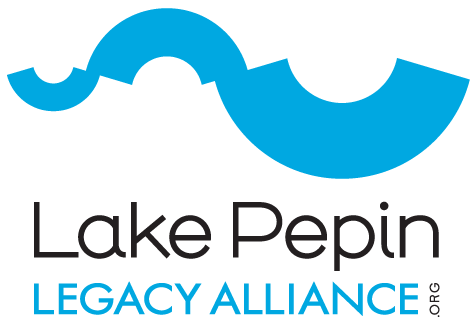Earlier this month we shared the Minnesota Department of Natural Resources (DNR) press release on the largest single capture of invasive carp in Minnesota & Wisconsin’s waters. In January and February of 2024, Lake Pepin Legacy Alliance (LPLA) and Friends of the Mississippi River will be co-leading a series of community meetings in St. Paul, Red Wing, and Winona, MN (virtual option available, too) to provide more information on this issue. Registration is now open.
In 2014, the Minnesota DNR updated their Invasive Carp Action Plan, which was designed to assess the threat posed by bighead, grass, and silver carp, and identify actions to minimize their impact in Minnesota. They cautioned that the technology was not available to accurately determine the abundance of invasive carp in the Mississippi River and no technology existed that would offer a 100% deterrence to the upstream migration of carp. They did identify evidence suggesting modified operating procedures at Lock and Dams #2 (Hastings), #5 (Minnesota City), and #8 (Genoa, WI) may hold hope for halting or slowing their spread up the Mississippi, Minnesota, and St. Croix Rivers.
Nine years later, on November 30, 2023, the Minnesota DNR confirmed capture of 323 invasive carp near Trempealeau, Wisconsin. This is the largest single capture of invasive carp that has occurred in Minnesota to date. The largest previous catch in the same location was 51. The larger numbers are due, in part, to improved fishing technology and not necessarily because the carp weren’t already there.
In LPLA’s 2023 Annual Report we shared responses to our own interview with Minnesota lead carp physiology and behavior researcher. Here’s what we learned:
Q: What is the status of carp in the Mississippi River?
A: They have moved beyond Lock and Dam 8, which was entirely predictable. Carp have a natural drive to swim upstream to reproduce. They can swim through the spillway gates when the water levels are high. The more likely reason carp are not reproducing in Minnesota yet is because the spillway gates are lower, and the locks and dams are more challenging to get through. At Lock and Dam 5, the spillway gates are only out of the water 2% of the time. Lock and Dam 4 is also a strong place to stop them from moving upstream. We can stop 99% of carp at almost no cost, just by regulating the spillway gates and putting a deterrent in the water.
We can reduce the number of carp moving upstream further if Lock and Dam 4 and 5 work in tandem to protect Lake Pepin by regulating the spillway gates – even just adjusting them 2 inches. Then you can add a bioacoustics fence to deter even more from coming through. Ultimately, the fewer that get through, the less likely the chances are of reproducing in Lake Pepin. That chance Is never zero because some will inevitably come through and you just need the right number and for the male and female to find each other for the population to explode.
Q: How long do we have before invasive carp could start reproducing in Lake Pepin?
A: There is still a lot we do not know. Carp can swim fast, so they could swim from LaCrosse to Lake City in two days. Will they? We do not know. Evidence shows that carp like to reproduce when they have larger numbers – a strategy known as predator swamping. In Canada, they believe that 10 carp constitute a large enough population to reproduce. We do not know that number, but we do see that larger numbers tend to trigger reproduction. A year of big floods could allow them to take off.
The Minnesota DNR has updated their 10-year Invasive Carp Action Plan to reflect the past nine years of research and learnings. This new plan has not yet been released to the public, but will be available this winter. The Invasive Carp Community Action Meetings co-hosted by Lake Pepin Legacy Alliance and Friends of the Mississippi River will provide attendees with an opportunity to learn about the new plan, ask questions, and share feedback.
Registration is open for these meetings. Light snacks and beverages will be provided for those who attend in person.
January 24, 2024 - Red Wing, Minnesota | 5:00 - 7:00 PM
January 30, 2024 - St. Paul, Minnesota (virtual option available) | 5:00 - 7:00 PM
February 1, 2024 - Winona, Minnesota | 5:00 - 7:00 PM


